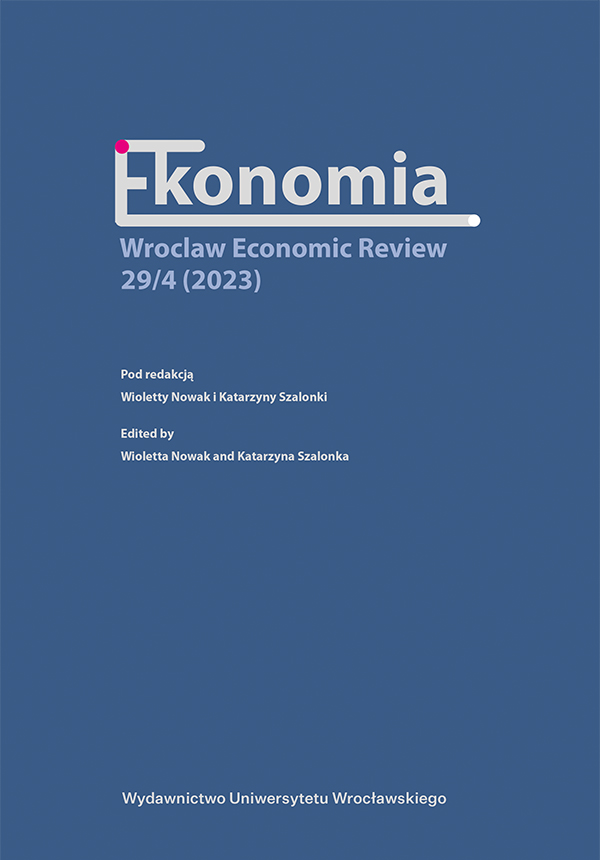

Artykuły

This article aims to identify the main areas of works devoted to the topic of counterfeit goods/brands consumption and to present the dynamics of changes in researchers’ interest in this subject. The research method used in the article was bibliometric analysis, complemented by content analysis of literature selected from the Scopus database. Research results: The main areas of research on the issue of counterfeit product consumption focused on 1) online consumer behavior and ethical aspects, 2) consumption of counterfeit products and brands, and 3) social aspects of consumption of counterfeit products. The earliest publications focus on purchasing behavior in the context of buying counterfeit products, followed by researchers who have focused on the ethical aspects of consuming counterfeit goods. More recent studies focus on the consumption and trade of counterfeit goods on the Internet. Conclusions: The ever-expanding global trade in counterfeit products poses a major challenge — it erodes business revenue, undermines innovation, and hampers economic growth. To effectively mitigate these phenomena, it is essential to have up-to-date knowledge of the latest scientific advances in the field. Research into the buyer behavior in the context of counterfeit goods can provide useful information for manufacturers about the scale of the problem and the possible need for remedial action.
Ang, S.H., Cheng, P.S., Lim, E.A.C., Tambyah, S.K. (2001). Spot the difference: Consumer responses towards counterfeits. Journal of Consumer Marketing, 18(3), 219–235. https://doi.org/10.1108/07363760110392967.
Bian, X., Haque, S., Smith, A. (2015). Social power, product conspicuousness, and the demand for luxury brand counterfeit products. British Journal of Social Psychology, 54(1), 37–54. https://doi.org/10.1111/bjso.12073.
Bupalan, K., Rahim, S.A., Ahmi, A., Rahman, N.A.A. (2019). Consumers’ repurchase intention towards counterfeit products. International Journal of Supply Chain Management, 8(3), 973–981.
Certilogo. (2022). How Counterfeit Goods Affect the Fashion Industry. Retrieved May 25, 2023, from https://www.discover.certilogo.com/blogs/insights/how-counterfeit-goods-affect-fashion-industry.
Dias, C.S.L., Rodrigues, R.G., Ferreira, J.J. (2019). What’s new in the research on agricultural entrepreneurship? Journal of Rural Studies, 65, 99–115. https://doi.org/10.1016/j.jrurstud.2018.11.003.
Ejdys, J. (2016). Problematyka społecznej odpowiedzialności biznesu jako obiekt naukowych zainteresowań — wyniki analizy bibliometrycznej. Przegląd Organizacji, 4, 36–44. https://doi.org/10.33141/po.2016.04.06.
EUIPO. (2020). Co roku budżety państw w całej UE tracą 63.8 mld PLN dochodów z powodu podrabianych towarów. Retrieved May 25, 2023 from https://www.euipo.europa.eu/tunnel-web/secure/webdav/guest/document_library/observatory/documents/reports/2020_Status_Report_on_IPR_infringement/2020_Status_Report_on_IPR_infringement_pr_poland.pdf.
Gültekin, B. (2018). Influence of the love of money and morality on intention to purchase counterfeit apparel. Social Behavior and Personality, 46(9), 1421–1436. https://doi.org/10.2224/sbp.7368.
Hamdan, I.M.N. (2022). The perceived influence of COVID-19 lockdown on the circulation of counterfeit drugs and medical supplies through the electronic market. Journal of Pharmaceutical Health Services Research, 14(1), 14–19. https://doi.org/10.1093/jphsr/rmac053.
Islam, T., Pitafi, A.H., Akhtar, N., Xiaobei, L. (2021). Determinants of purchase luxury counterfeit products in social commerce: The mediating role of compulsive internet use. Journal of Retailing and Consumer Services, 62, 102596. https://doi.org/10.1016/j.jretconser.2021.102596.
Jun, S.P., Yoo, H.S., Choi, S. (2018). Ten years of research change using Google Trends: From the perspective of big data utilizations and applications. Technological Forecasting and Social Change, 130, 69–87. https://doi.org/10.1016/j.techfore.2017.11.009.
Karakose, T., Yirci, R., Papadakis, S., Ozdemir, T.Y., Demirkol, M., Polat, H. (2021). Science mapping of the global knowledge base on management, leadership, and administration related to COVID-19 for promoting the sustainability of scientific research. Sustainability, 13(17), 9631. https://doi.org/10.3390/su13179631.
Kim, C., Ko, E., Koh, J. (2016). Consumer attitudes and purchase intentions toward fashion counterfeits: Moderating the effects of types of counterfeit goods and consumer characteristics. Journal of Global Fashion Marketing, 7(1), 15–29. https://doi.org/10.1080/20932685.2015.1105109.
Mayasari, I., Haryanto, H.C., Wiadi, I., Wijanarko, A.A., Abdillah, W. (2022). Counterfeit purchase intention of fashion brands: The personal values and social aspect of consumers as determinants. Gadjah Mada International Journal of Business, 24(1), 1–24. https://doi.org/10.22146/gamaijb.54660.
Mongeon, P., Paul-Hus, A. (2016). The journal coverage of Web of Science and Scopus: A comparative analysis. Scientometrics, 106(1), 213–228. https://doi.org/10.1007/s11192-015-1765-5.
Morwitz, V. (2014). Consumers’ purchase intentions and their behavior. Foundations and Trends in Marketing, 7(3), 181–230. https://doi.org/10.1561/1700000036.
Mróz, B. (2016). Online piracy: An emergent segment of the shadow economy. Empirical insight from Poland. Journal of Financial Crime, 23(3), 637–654. https://doi.org/10.1108/JFC-04-2015-0022.
OECD-EUIPO. (2019). Trends in Trade in Counterfeit and Pirated Goods, Illicit Trade. Retrieved May 25, 2023, from https://www.euipo.europa.eu/tunnel-web/secure/webdav/guest/document_library/observatory/documents/reports/trends_in_trade_in_counterfeit_and_pirated_goods/trends_in_trade_in_counterfeit_and_pirated_goods_en.pdf.
Pavlou, P.A. (2003). Consumer acceptance of electronic commerce: Integrating trust and risk with the technology acceptance model. International Journal of Electronic Commerce, 7(3), 101–134. https://doi.org/10.1080/10864415.2003.11044275.
Rocha, P.I., Caldeira de Oliveira, J.H., Giraldi, J. de M.E. (2020). Marketing communications via celebrity endorsement: An integrative review. Benchmarking, 27(7). https://doi.org/10.1108/BIJ-05-2018-0133.
Shah, S.H.H., Lei, S., Ali, M., Doronin, D., Hussain, S.T. (2020). Prosumption: Bibliometric analysis using HistCite and VOSviewer. Kybernetes, 49(3), 1020–1045. https://doi.org/10.1108/K-12-2018-0696.
Shvindina, H. (2019). Coopetition as an emerging trend in research: Perspectives for safety and security. Safety, 5(3), 61. https://doi.org/10.3390/safety5030061.
Singh, A., Patel, A.K., Parayitam, S. (2022). The relationship between functional theory of attitudes and purchase intention of counterfeit luxury sunglasses: A moderated moderated-mediation conditional model. Journal of Global Fashion Marketing, 13(4), 304–327. https://doi.org/10.1080/20932685.2022.2061554.
Souiden, N., Ladhari, R., Zarrouk Amri, A. (2018). Is buying counterfeit sinful? Investigation of consumers’ attitudes and purchase intentions of counterfeit products in a Muslim country. International Journal of Consumer Studies, 42(6), 687–703. https://doi.org/10.1111/ijcs.12466.
Ting, M.S., Goh, Y.N., Isa, S.M. (2016). Determining consumer purchase intentions toward counterfeit luxury goods in Malaysia. Asia Pacific Management Review, 21(4), 219–230. https://doi.org/10.1016/j.apmrv.2016.07.003.
Van Eck, N.J., Waltman, L. (2010). Software survey: VOSviewer, a computer program for bibliometric mapping. Scientometrics, 84(2), 523–538. https://doi.org/10.1007/s11192-009-0146-3.
VOSviewer. (n.d.). Highlights. Retrieved May 29, 2023, from https://www.vosviewer.com/features/highlights.
Wang, W., Liao, Y., Shen, W. (2023). The impact of online anti-counterfeiting on channel structure and pricing decisions. Sustainability, 15(10), 8253. https://doi.org/10.3390/su15108253.
Zema, T., Sulich, A. (2022). Models of electricity price forecasting: Bibliometric research. Energies, 15(15), 5642. https://doi.org/10.3390/en15155642.